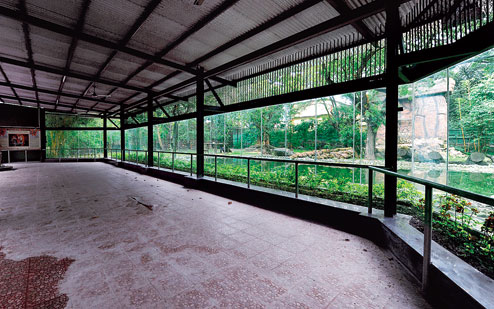 |
 |
| The glass facade (top) along the visitor platform next to the new tiger cage; (above) the aviary. (Sanjoy Ghosh) |
A tiger room with a view and most of the top-draw birds under one dome-shaped roof — Alipore zoo will add new feathers to its wings before the visitors roar in this winter.
Chief minister Mamata Banerjee will soon unveil a glass enclosure for tiger viewing at the zoo and an aviary, both meant to give the inhabitants a better place to stay and enable visitors to see them clearly. Metro presents a first look at the facilities.
The den
Spread over 3,300sq metre, the enclosure with a glass facade has been built next to the existing tiger facility.
The idea has been to produce a natural tiger habitat at the zoo and the authorities have successfully recreated the details, including a hillock at the rear end of the cage and a waterfall. Three pumps will feed the fall and a purifier will keep the water clean.
What’s going to leave a long-lasting pugmark in every visitor’s heart is a clear view of the tigers through a giant glass wall next to a platform. “It will be like watching a movie in a theatre. Kids can see without any obstacle the big cats frolicking in the winter sun. Parents will not have to hold their kids up above their shoulders to show them the tigers,” said zoo director Kanai Lal Ghosh.
Made of toughened glass, the 10ft-high and 200ft-wide wall encircling the cage will muffle outside noise for the tigers. “We get more than 50,000 visitors a day during the winter months. Naturally, the sound barrier crosses the limit too. The glass wall will act as a sound barrier and minimal noise can reach the big cats. This will help them remain calm,” Ghosh said.
“It’s a first. No other zoo in India has a glass enclosure like this. No more peeking through the protective wire mesh and hedge here!” a zookeeper said.
The new cage doesn’t have a concrete floor, unlike the existing ones. “There’s an earthy feel to it with shrubs and plants in and around the enclosure. The tigers will love it,” he added.
Ghosh said the wall would stop — without spoiling the view — the visitors from getting too close to the tigers.
The zoo authorities have planned to test the glass enclosure by putting one tiger initially. “Tigers are territorial. They prefer staying alone. We will gradually increase the number of tigers in the enclosure if the animals get along fine,” an official said.
Another long-term plan is to turn the all the tiger cages into glass homes. Until then, the white tiger’s open-air enclosure and the other cages will remain open to the public.
The nest
Most of the 50 species of birds in the zoo will check into a 720sq-metre circular aviary with a dome-shaped top. And the birds will have the elephants as neighbours.
“The plan is to display almost all the birds on the visitors’ check list, including spoonbills, macaws, cranes, pelicans and pea fowls. These are big draws,” Ghosh said.
“The idea is to bring most of our birds under one roof. The visitors will no longer have to go cage-hopping to catch a glimpse of their favourite birds,” an official said. “Having all the birds in one place will help people, especially children, distinguish the species,” he added.
The authorities hoped that the design of the aviary — circular and open — would cut overcrowding and reduce noise. A mesh will prevent visitors from throwing “food or other harmful projectiles” at the birds.

